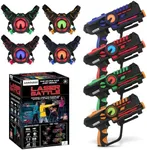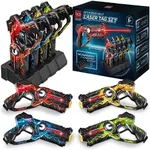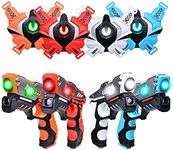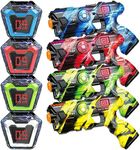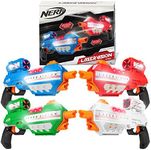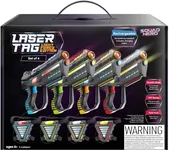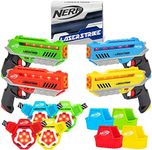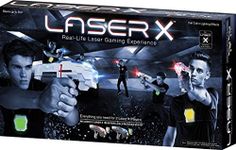Buying Guide for the Best Laser Tag Guns
Choosing the right laser tag gun can make your games much more enjoyable, whether you're playing casually with friends or organizing larger events. The best approach is to think about who will be using the guns, where you'll be playing (indoors or outdoors), and what kind of experience you want—fast-paced action, team strategy, or just simple fun. Understanding the main features will help you pick a set that matches your needs and ensures everyone has a great time.RangeRange refers to how far the laser tag gun can accurately register hits. This is important because it determines the size of the area you can play in and how dynamic your games can be. Short-range guns (up to 50 feet) are best for indoor play or small backyards, making them safer and easier for younger players. Medium-range guns (50-150 feet) offer more flexibility and are good for both indoor and outdoor use. Long-range guns (over 150 feet) are ideal for large outdoor spaces and more competitive play. Think about your typical play area and choose a range that fits—if you mostly play indoors, you don’t need a long-range gun.
Number of Teams/ModesThis spec tells you how many teams can play at once and what game modes are available, such as solo, team, or special missions. More teams and modes add variety and keep the game interesting, especially for larger groups or frequent play. Basic sets may only allow two teams and a few modes, which is fine for simple games. Advanced sets can support four or more teams and offer multiple modes like capture the flag or free-for-all. If you want more variety or have a big group, look for guns with more team and mode options.
Hit DetectionHit detection is how the gun or vest senses when a player has been tagged. Some guns have built-in sensors, while others use separate vests or headbands. Built-in sensors are simpler and easier for quick games, but vests or headbands can make the experience more immersive and accurate. If you want a more realistic or competitive game, consider sets with separate vests or headbands. For casual or younger players, built-in sensors are usually enough.
Durability and Build QualityDurability refers to how well the laser tag guns can withstand drops, bumps, and rough play. This is important, especially for kids or outdoor use. Lightweight plastic guns are easier for younger children to handle but may not last as long. Heavier, sturdier models are better for older kids and adults who play more aggressively. Think about who will be using the guns and how rough the play might get—choose a build quality that matches your needs.
Battery Life and Power SourceBattery life determines how long you can play before needing to recharge or replace batteries. Some guns use standard AA or AAA batteries, while others have built-in rechargeable batteries. Longer battery life is important for extended play sessions or events. If you don’t want to worry about frequent recharging, look for guns with longer battery life or the ability to swap out batteries easily. For occasional play, shorter battery life may be less of an issue.
Sound and Light EffectsSound and light effects add excitement and realism to the game, making it more engaging. Some guns have loud, dramatic effects, while others are quieter and more subtle. If you’re playing indoors or in noise-sensitive areas, you might prefer quieter guns or those with adjustable volume. For outdoor or party play, louder and more vibrant effects can make the game more fun. Consider your play environment and choose effects that suit your group.


